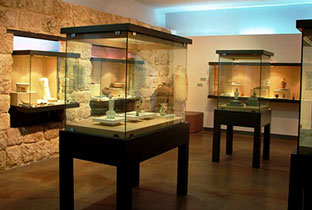Diaspora Museum
Four Tel Aviv Museums Not to Miss
1. Diaspora Museum Tel Aviv
Also known as Beit Hatfutsot or Museum of the Jewish People, the Diaspora Museum is situated in Ramat Aviv near the Tel Aviv University.

Talmoryair CC BY 3.0
Rubin Museum
The change in its English name from the Museum of the Diaspora to the Museum of the Jewish People reflects the enormous changes in progress at this flagship museum. The entire core exhibition is being overhauled in terms of content and technology, taking the emphasis off of the Diaspora and placing it back onto the history of the entire Jewish people, from Biblical times in Canaan to Israel today, with more emphasis on modern times.
The renovations, slated to be finished by 2014, are using state-of-the-art technology to restore the Diaspora Museum to its former glory days.
One of Israel’s most important historical museums, it is certainly worth visiting, even during the renovations. There are many fascinating temporary and permanent exhibitions as well as the unique Jewish Genealogy section which has enabled thousands of families to trace their family trees. Over three million individuals have already been recorded in the databases.
2. Rubin Museum
Another not-to-be-missed Tel Aviv museum is the Rubin Museum on Bialik Street, housed in Reuven Rubin’s former home where he lived with his family from 1946 – 1974. Rubin is considered one of Israel’s most famous painters and his studio has been preserved intact for visitors to see. There are permanent exhibitions, various changing exhibitions, and a slideshow about his life and works. In the basement is a children’s workshop where children are encouraged to leave their work for display. The reading room on the upper floor is kept updated with works on Israeli and Jewish art to supplement the large library that belonged to the Rubin family.
3. David Ben Gurion
The David Ben Gurion home is located in a busy, unpretentious section of Tel Aviv, on the road now named Ben Gurion Boulevard. Built in the 1930s, it was the home of the Ben Gurion family until they moved to Sde Boker in 1953. Even after moving to Sde Boker, David Ben Gurion used this building as his second home when he needed to be in the center of the country.
The downstairs area has a kitchen and a bedroom; upstairs, where Ben Gurion as Prime Minister spent most of his time, there is a bedroom and four library rooms. Here you will find over 20,000 books in a multitude of languages from Ben Gurion’s private library. He bequeathed his home to the State of Israel and it was opened it to the public in 1976 for ‘perusal and research’.
4. Jabotinsky Museum
This centrally placed Tel Aviv museum, at 38 King George Street, is a tribute to Ze’ev Jabotinsky, the head of the Revisionist Zionist Movement who was so influential in the founding of the State of Israel and the development of many of its leaders. Jabotinsky died of a heart attack in 1940 while visiting one of the self-defense camps run by his movement Beitar in New York. Originally buried there, he was re-interned in 1964 in Jerusalem.
His unapologetic beliefs about the right of the Jewish people to self-government in their own homeland are clearly spelled out in his writings, but much of the Jabotinsky Museum has been updated using state-of-the-art technology to provide visitors with a feel of what life was like during pre-State times. In one section visitors can experience being on one of the famous unseaworthy vessles which brought over thousands of illegal immigrants, survivors of Nazi Europe, who hoped for safety in British Mandate Palestine.
Diaspora Museum Trivia: Did You Know?
In addition to the Diaspora Museum, there are more than 75 museums in the Tel Aviv area.









